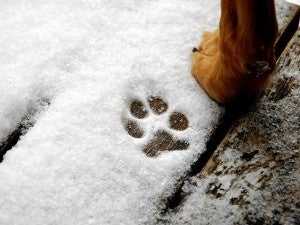How to Exercise Your Dog in Cold Weather

Wintry weather is no excuse to slack on your dog’s exercise. Dogs need physical activity every day, or else she's at risk of becoming stressed, under-stimulated and overweight. If you don't provide your pup with outlets for energy, they may develop behavioral problems such as whining, excessive barking, digging, chewing, biting or playing too rough, according to WebMD.
This doesn't change just because Mother Nature turns down the thermostat. Some dogs have no problem braving the cold and snow, but others need encouragement to embrace chilly days and chilly play. Talk to your veterinarian about how strenuously and for how long you should exercise your pet. Your dog's age, general health and characteristics of their breed's physiology affect what she can comfortably and safely do.
Make Time Outdoors More Exciting
Upgrade a standard backyard romp to a trip to the dog park, a nature trail or another enticing locale. Or, just walk a different route than you usually do. Changes in scene excite and mentally stimulate your dog. You probably can't go somewhere new and exciting every day, so introduce novel forms of play in your own yard. Pick up a few new toys or use items from your home and yard to design a doggy obstacle course. Also, arrange to take your dog out with other dogs, or hire a dog walker if necessary. When you go out, bring a few treats and use them to reinforce a positive cold-weather outdoor experience.
Protect Your Dog’s Paws
You can’t blame your dog for not liking to walk around outside when the cold ground, snow, ice, salt and chemical de-icers burn, sting, dry and crack her paws. On VetStreet.com, professional dog trainer Mikkel Becker, recommends dog booties with secure traction and Velcro straps to protect your pup’s paws and keep them warm. Get her accustomed to them at home first, offering treats and praise as positive reinforcement. If your dog simply won't wear booties, Becker suggests petroleum jelly or a commercial protective gel for canine paw pads. Wipe off your dog’s paws immediately after returning home so she doesn't ingest gel, rock salt or other de-icers while licking.
Keep Your Dog’s Body Warm
Lots of dogs have built-in coats that can handle cold weather, but many benefit from the additional warmth provided by a doggy jacket or vest, especially in really low temperatures or for extended excursions. Puppies, elderly dogs and smaller breed dogs in particular need the bundling, Becker says. Select a water-repellant item and make sure it's dry before you put it on your pet again for your next outdoor play date. Wet clothing and cold weather aren't a great combination.
Know When It’s Too Cold
Providing fresh air, exercise and stimulation for your dog during the cold weather is important, but there is such a thing as too cold. As a general rule, if it’s too frigid for you, it’s probably too cold for your dog, too. Remember, young and senior dogs and those with conditions such as arthritis struggle even more in the cold. Watch for signs that your pooch can't handle the deep chill; they can include shaking, cowering, repeatedly lifting up her feet and continuously trying to go back inside.
Indoor Exercise Options
For when it's simply too cold out, or when other inclement weather or dangerous conditions won't let you and your dog get outside, turn to indoor activities that encourage movement and stimulation. If you have a long enough hallway you can clear out, use it for a game of fetch or tug-of-war. Playing fetch up and down a stairway works well, too. Or, play hide-and-seek or put out a trail of treats for your dog to sniff and follow. Don't overlook indoor options away from home, either. Pet spas, heated indoor dog pools and doggy exercise or yoga classes offer physical activity, mental stimulation and socialization, even when the weather outside is frightful.